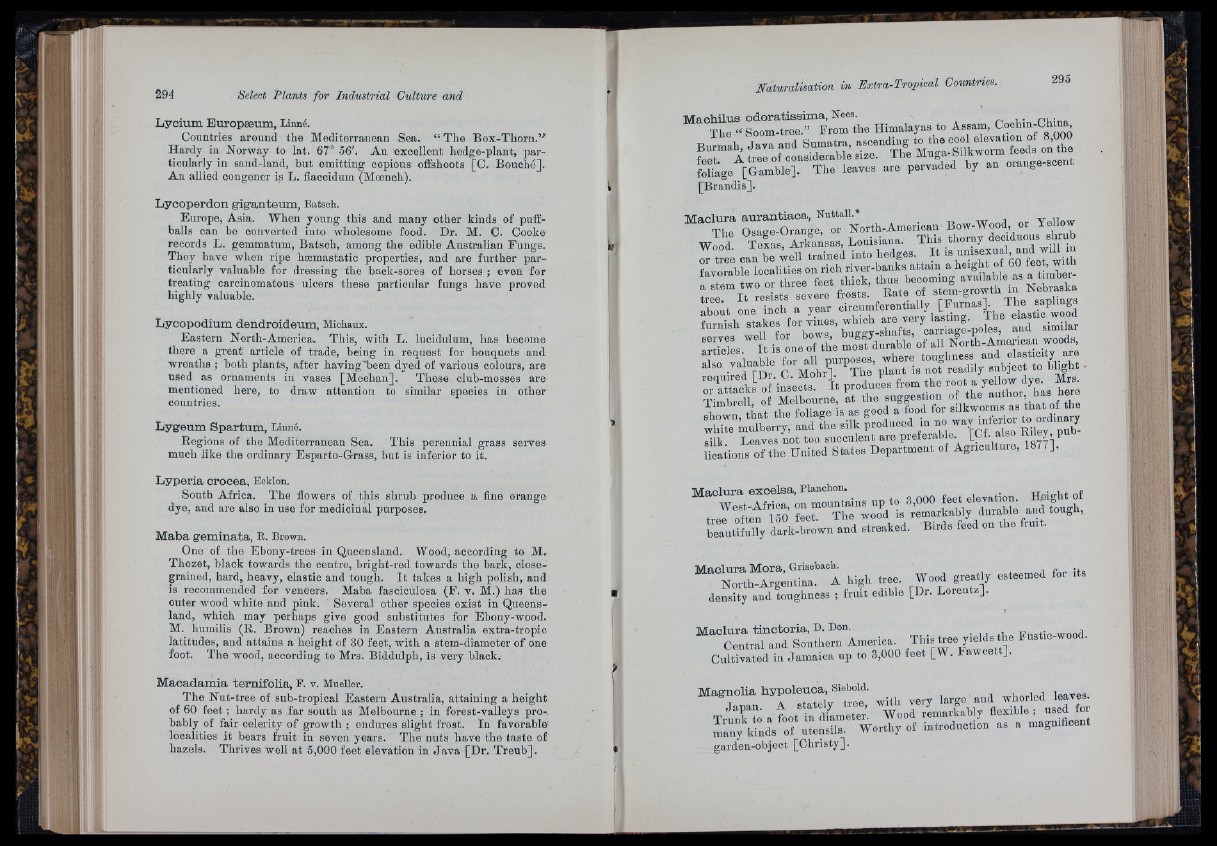
m Lyeium Buropæum, Linné.
Countries around the Mediterranean Sea. “ The Box-Thorn.”
Hardy in Norway to lat. 67° 56'. An excellent liedge-plant, particularly
in sand-land, bnt emitting copious offshoots [0 . Bouché].
An allied congener is L. flaccidum (Moench).
Lycoperdon gig-anteum, Batsch.
Europe, Asia. When young this and many other kinds of puffballs
can be converted into wholesome food. Dr. M. C. Cooke
records L. gemmatum, Batsch, among the edible Australian Fungs.
They have when ripe hæmastatic properties, and are further particularly
valuable for dressing the back-sores of horses ; even for
treating carcinomatous ulcers these particular fungs have proved
highly valuable.
Lycopodium dendroideum, Michaux.
Eastern Nortli-America. This, with L. lucidnlum, has become
there a great article of trade, being iu request for bouquets and
wreaths ; both plants, after liaving'been dyed of various colours, are
used as ornaments in vases [Meehan]. 'These club-mosses are
mentioned here, to draw attention to similar species in other
countries.
Lygeum Spartum, Linné.
Regions of the Mediterranean Sea. This perennial grass serves
much like tlie ordinary Esparto-Grass, hut is inferior to it.
Lyperia crocea, Ecklon.
South Africa. The flowers of this shrub produce a fine orange
dye, and are also in use for medicinal purposes.
Maba gemmata, B. Brown.
One of the Ebony-trees in Queensland. Wood, according to M.
Thozet, black towards the centre, bright-red towards the bark, close-
p a in ed , hard, heavy, elastic aud tough. I t takes a high polish, and
is recommended for veneers. Maba fasciciilosa (F. v. M.) has the
outer wood white and pink. Several other species exist in Queensland,
which may perhaps give good substitutes for Ebony-wood.
M. humilis (R. Brown) reaches in Eastern Australia extra-tropic
latitudes, and attains a height of 30 feet, with a stem-diameter of one
foot. 'The wood, according to Mrs. Biddulph, is very black.
Macadamia ternifolia, E. v. Mueller.
The Nut-tree of sub-tropical Eastern Australia, attaining a height
of 60 feet ; hardy as far south as Melbourne ; in forest-valleys pro-,
bably of fair celerity of growth ; endures slight frost. In favorable
localities it bears fruit in seven years. The niits have the taste of
hazels. 'Thrives well a t 5,000 feet elevation in J a v a [Dr. Treub].
^ ® ° S r ^ ‘ £ o T Í r “ F Í t h e Himalayas to Assam,
foliége [Gamble]. The leaves aro pervaded by an orange-sce
[Brandis].
M a d u r a a u r a n t ia c a , Nuttall.* „ w „r V pIIow
The Osaee-Orange, or North-American Bow-Wood, or Yellow
w lo d T e ia s , Arka/sas, Louisiana. This thorny
or treé can be well trained into hedges. I t k ^ f L l with
favorable localities on rich river-banks attain a height of 60
a stem two or three feet thick, ^“ r s t e ^ i - r r "
walso valuablem for all purposesm, where tougluiesss amnd
also 7 "® I t is not readily subject to bligHt ■
whiTe mulberry, and the silk produced in no ^vay mfenor to ordinary
silk Leaves not too succulent are preferable [Cf- also P“ “
ilcations o fth e United States Department of Agricultme, 1877].
M a d u r a e x c e ls a . Planchón. elevation. Height of
S k S - . ...1 « ,= .1 .1 . Birds f ..d . . . .ir . ,ru...
M a d u r a M o ra , Grisebach.
North-Argeiitina. A high tree. Wood greatly esteemed for
density and toughness ; fruit edible [Dr. Lorentz].
“ e f f i r l f a t d t r a d ^ Bustic-wood.
Cultivated in Jamaica up to 3,000 feet [W. law c e ].
M a g n o lia h y p o le u c a , Siebold.
garden-object [Christy].